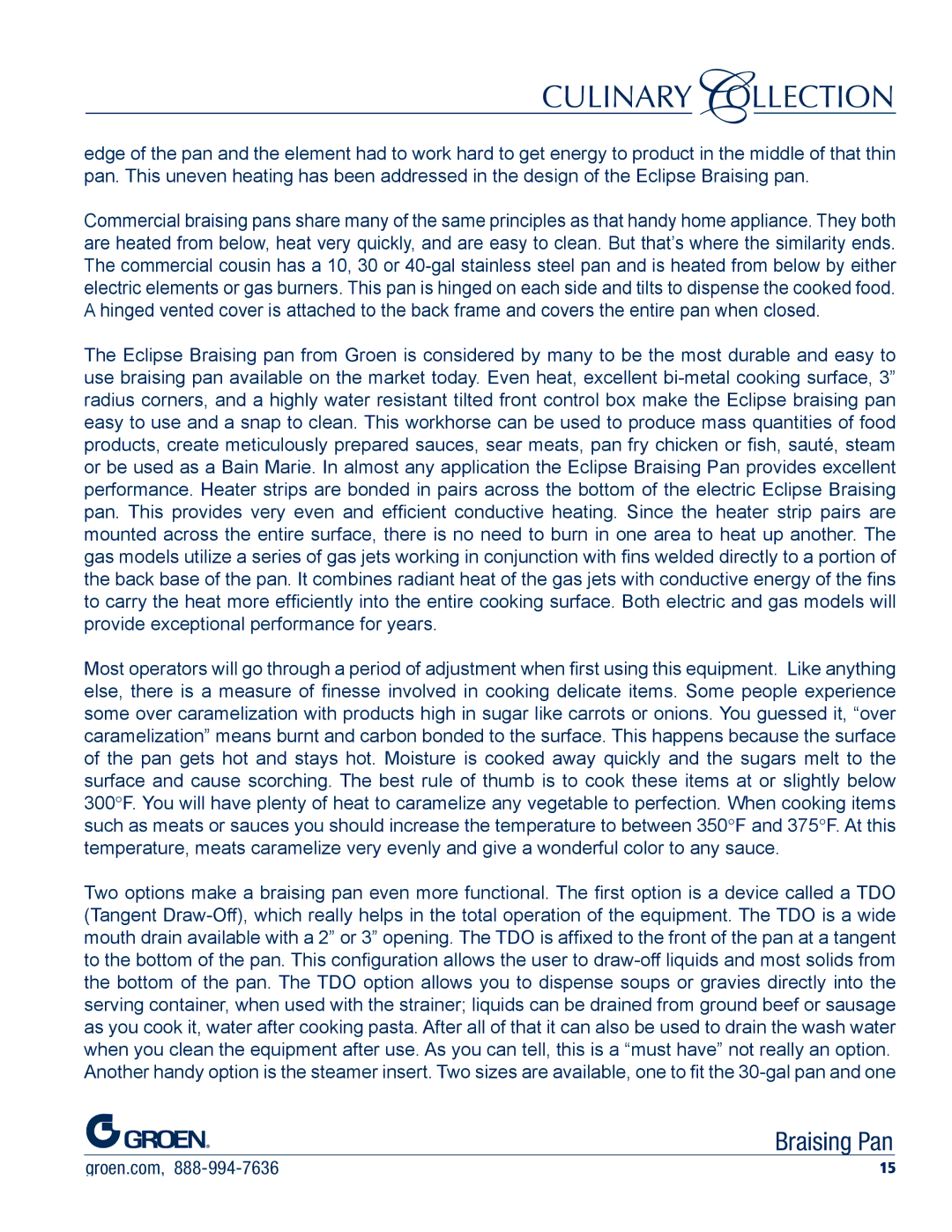edge of the pan and the element had to work hard to get energy to product in the middle of that thin pan. This uneven heating has been addressed in the design of the Eclipse Braising pan.
Commercial braising pans share many of the same principles as that handy home appliance. They both are heated from below, heat very quickly, and are easy to clean. But that’s where the similarity ends. The commercial cousin has a 10, 30 or 40-gal stainless steel pan and is heated from below by either electric elements or gas burners. This pan is hinged on each side and tilts to dispense the cooked food. A hinged vented cover is attached to the back frame and covers the entire pan when closed.
The Eclipse Braising pan from Groen is considered by many to be the most durable and easy to use braising pan available on the market today. Even heat, excellent bi-metal cooking surface, 3” radius corners, and a highly water resistant tilted front control box make the Eclipse braising pan easy to use and a snap to clean. This workhorse can be used to produce mass quantities of food products, create meticulously prepared sauces, sear meats, pan fry chicken or fish, sauté, steam or be used as a Bain Marie. In almost any application the Eclipse Braising Pan provides excellent performance. Heater strips are bonded in pairs across the bottom of the electric Eclipse Braising pan. This provides very even and efficient conductive heating. Since the heater strip pairs are mounted across the entire surface, there is no need to burn in one area to heat up another. The gas models utilize a series of gas jets working in conjunction with fins welded directly to a portion of the back base of the pan. It combines radiant heat of the gas jets with conductive energy of the fins to carry the heat more efficiently into the entire cooking surface. Both electric and gas models will provide exceptional performance for years.
Most operators will go through a period of adjustment when first using this equipment. Like anything else, there is a measure of finesse involved in cooking delicate items. Some people experience some over caramelization with products high in sugar like carrots or onions. You guessed it, “over caramelization” means burnt and carbon bonded to the surface. This happens because the surface of the pan gets hot and stays hot. Moisture is cooked away quickly and the sugars melt to the surface and cause scorching. The best rule of thumb is to cook these items at or slightly below 300°F. You will have plenty of heat to caramelize any vegetable to perfection. When cooking items such as meats or sauces you should increase the temperature to between 350°F and 375°F. At this temperature, meats caramelize very evenly and give a wonderful color to any sauce.
Two options make a braising pan even more functional. The first option is a device called a TDO (Tangent Draw-Off), which really helps in the total operation of the equipment. The TDO is a wide mouth drain available with a 2” or 3” opening. The TDO is affixed to the front of the pan at a tangent to the bottom of the pan. This configuration allows the user to draw-off liquids and most solids from the bottom of the pan. The TDO option allows you to dispense soups or gravies directly into the serving container, when used with the strainer; liquids can be drained from ground beef or sausage as you cook it, water after cooking pasta. After all of that it can also be used to drain the wash water when you clean the equipment after use. As you can tell, this is a “must have” not really an option. Another handy option is the steamer insert. Two sizes are available, one to fit the 30-gal pan and one
Braising Pan

